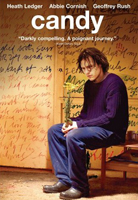BUY IT AT AMAZON: CLICK HERE!
STUDIO: Thinkfilm
MSRP: $27.98
RATED: R
RUNNING TIME: 108 Minutes
SPECIAL FEATURES:
• Feature commentary w/ director and writer
• Two behind-the-scenes featurettes
• Trailers
The Pitch
"Requiem
for a Dream meets vector math."
The Humans
Heath
Ledger, Geoffrey Rush, Abbie Cornish.
The Nutshell
Dan
(Ledger) loves Candy (Cornish). Dan loves drugs, and so does Candy. Dan and Candy
compete for drugs’ affections, but drugs can’t make up their mind and instead
kill Geoffrey Rush, who never did anything mean to them. Ian’s head gets sad.
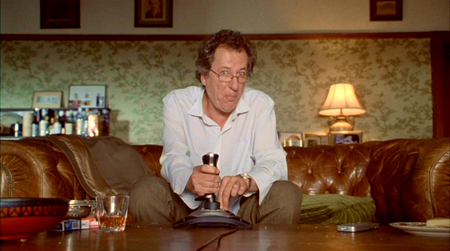
If Tera Patrick could see out of her interactive DVD…
The Lowdown
Writers
love to impress forms on fiction. The process of rendering a story to its core
elements, free of the random insertions of regular life, lends itself well to arrangement
in a familiar configuration. Sometimes, as with Candy, the events that
the process ends up with hold very little distinction from similar renderings. If
you’ve seen one movie about the relationships of druggies, you have a solid
understanding of how they all function. In these cases, a pair of focal points
rise to take hold of the audience’s interest: the skill of the filmmaking, and
the shape that the events are laid into.
(A brief,
anecdotal interjection, not at all in keeping with the format of the review: I
find it very difficult to watch movies about junkies. Requiem for a Dream broke
me up terribly; Trainspotting hurt to a greater degree than it humored. The
convenient metaphorical space that drugs inhabit draws my emotions much more
strongly than it does critical thought.
Here’s
the shape that director Neil Armfield arranged the events of Candy
into:
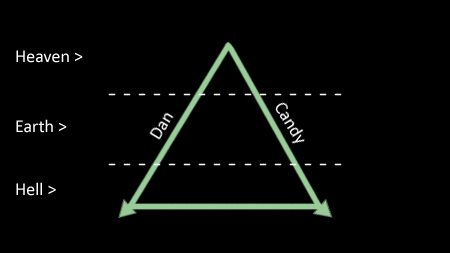
Much like
Requiem
for a Dream was divided into sections based on season, Candy
is sectioned into three periods: Heaven, Earth, and Hell, with each chapter
bearing those events with the emotional content that the heading suggests. The
gradual descent is well-reflected in the director’s technique and style for
each, from dreamlike montage in "Heaven" to swarms of condemning
voices in "Hell."
The final
resting places of both Candy and Dan are no surprise, taking place in Hell as
they do, but their origin is worth taking a brief look at. The film that was
brought to my mind, as the vectors of the two characters began to accelerate
away from each other, was Kiyoshi Kurosawa’s Pulse. The central visual
metaphor of that film is that humans can not get close to one another; it’s
impossible for two people to form a true bond, and the universe deals with this
impossibility by canceling them out. The physics are a little different in Candy;
instead of removing the people of concern, the universe sends them flying apart
like identical magnetic poles repelling from the point where they made their
closest, fumbling contact.
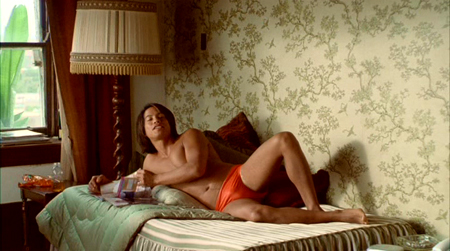
"Nein. Ich bin Berliner."
So, Dan
and Candy push gradually away from each other as they follow their descents.
That accounts for two dimensions, but, stretching the conceit to its breaking
point, a strong film requires three-dimensional conflict and character. Candy
possesses very little of either, using the definition that a well-rounded story
can take you to unexpected places without violating its own coherency. The
problem is that Candy doesn’t go to unexpected places. Like most junkie films,
it follows a predictable path from the first taste of the drug, to abandon, to
the inevitable attempt at cleaning up, to falling off the wagon, nervous
breakdown, and beyond. At times, the characters don’t even hold sufficient
motivation to follow this well-worn path.
Heath
Ledger’s notable charisma floats above it all. Even if Dan isn’t a fully
believable character, there’s nothing that prevents lovely character work from
appearing in two-dimensional fiction. Abbie Cornish supports him decently
enough, but there’s only a single scene, involving a miscarriage, in which
their cooperative craft reaches full maturity. It’s a hell of a scene, though.
These stretches of aren’t remain not quite enough to extend a third dimension
on the proceedings.
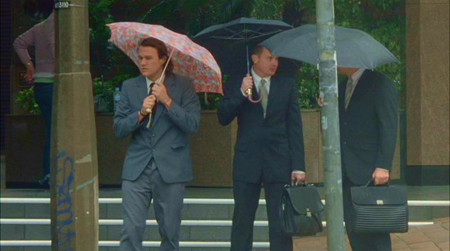
I’ll concede that this was unexpected.
Candy‘s fascinating structure, and the
practiced and skillful direction, provide the audience with a neatly packaged spread
of food for introspection, but not a wholly involving work of fiction. The
confession is: it broke me down, and it gave me plenty to write about. That’s
not much of a recommendation, but it’s certainly an honest one.
The Package
The disc
contains two featurettes: a behind-the-scenes short called "Candy: The
Path to Wild Abandon," and an expansion on one of the film’s key scenes in
"Writing on the Wall: Candy’s Poem in Motion." There’s also a low-key
commentary track with director Neil Armfield and writer Luke Davies, who also
penned the novel on which the film is based. The track teases a bit more depth
out of the characterizations and plot, which makes it a worthy companion.
There are
also trailers, trailers everywhere, nor any drop to drink.
6 out of 10
